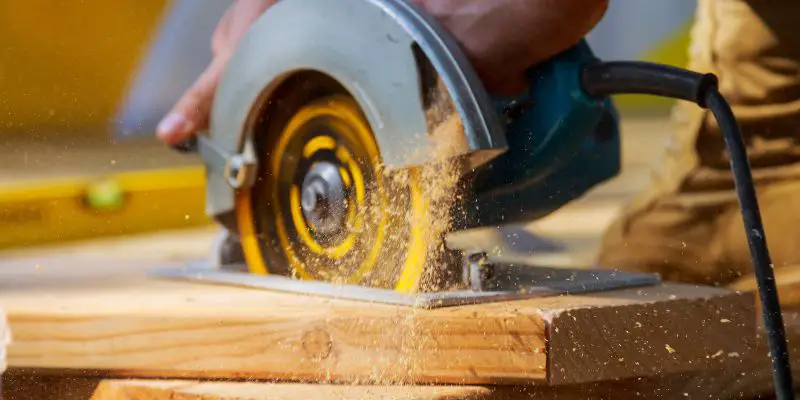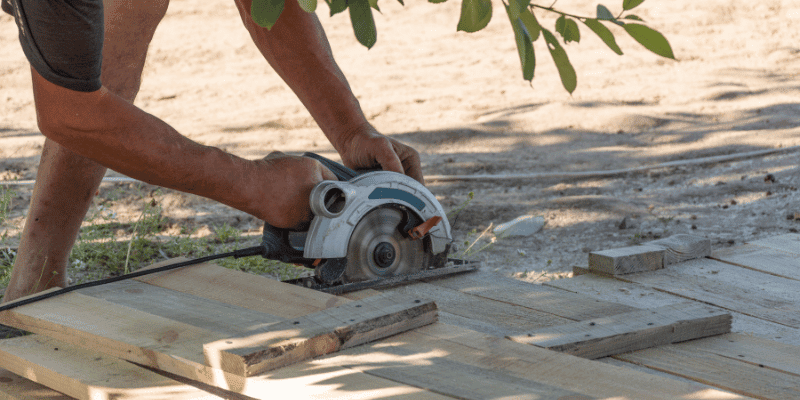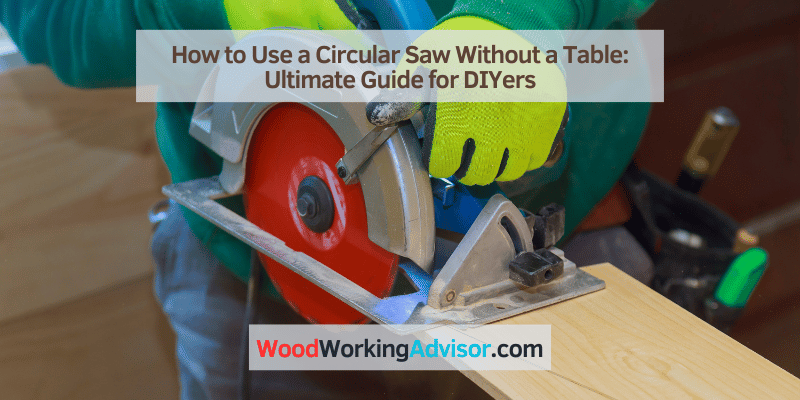To use a circular saw without a table, securely hold the wood and make sure to have a stable surface for cutting. Using a circular saw without a table can be a versatile and efficient way to make precise cuts in wood.
Whether you are working on a job site or tackling a DIY project at home, knowing how to properly use a circular saw without a table can greatly improve your woodworking skills. In this guide, we will cover the essential steps and precautions for safely and effectively using a circular saw without a table, as well as some tips for achieving accurate results.
By following these instructions, you can confidently tackle cutting tasks without the need for a dedicated table or workbench.
Circular Saw Basics For Diy Enthusiasts
Welcome to our guide on understanding the basics of circular saws for DIY enthusiasts. In this blog post, we will explore how to use a circular saw without a table, the essential safety measures to consider, and some helpful tips for effective operation. Whether you’re a seasoned DIY enthusiast or a beginner looking to expand your skills, this comprehensive guide will provide you with the knowledge and confidence to use a circular saw with ease and precision.
Understanding Circular Saws And Their Components
Before delving into using a circular saw without a table, it’s crucial to familiarize yourself with the essential components of this versatile tool. A standard circular saw comprises the following key elements:
- Circular Blade: The circular blade is responsible for making precise cuts in various materials. It’s important to select the appropriate blade for your specific cutting needs, whether it’s for wood, metal, or other materials.
- Base Plate: Also known as the shoe, the base plate provides stability and support during cutting operations. It can be adjusted to achieve different cutting depths and angles.
- Motor and Power Source: Circular saws are available in corded and cordless models, each powered by a motor that drives the rotation of the blade.
- Handle and Trigger: The handle allows for a comfortable grip, while the trigger controls the activation of the saw.

Safety Measures To Consider Before Use
Prior to operating a circular saw, it’s essential to prioritize safety to minimize the risk of accidents and injuries. Here are some crucial safety measures to adhere to:
- Protective Gear: Always wear appropriate protective gear, including safety glasses, ear protection, and gloves to safeguard yourself from potential hazards.
- Stable Work Surface: Ensure that the material being cut is firmly secured to a stable work surface to prevent unexpected movements.
- Inspect the Saw: Regularly inspect the saw for any damaged or worn components, ensuring that it is in optimal working condition before use.
- Unplug or Remove Batteries: When making adjustments or changing the blade, always disconnect the power supply or remove the batteries to prevent accidental start-ups.
- Follow Operating Instructions: Familiarize yourself with the manufacturer’s operating instructions and guidelines to use the circular saw safely and effectively.
Choosing The Right Circular Saw Blade
Choosing the right circular saw blade is essential for getting the best results from your tool. With the plethora of options available, it can be overwhelming to decide which blade to use for a specific project. Understanding the various blade types and the factors affecting blade selection can help you make an informed decision.
Blade Types And Their Uses
When it comes to circular saw blades, there are several types to choose from, each designed for specific cutting tasks. Here are some common blade types and their uses:
- Tungsten Carbide-Tipped (TCT) Blades: Ideal for cutting through wood, plywood, and other wood-based materials.
- Abrasive Blades: Suited for cutting materials like concrete, stone, and metal.
- High-Speed Steel (HSS) Blades: Best for cutting through soft metals and plastics.
- Diamond Blades: Specifically designed for cutting through hard and abrasive materials such as tile, ceramic, and natural stone.
Factors Affecting Blade Selection
Several factors should be taken into consideration when selecting a circular saw blade to ensure optimum performance:
- Material Type: The type of material being cut will dictate the blade type required for the job.
- Tooth Count: The number of teeth on the blade impacts the quality of the cut. Blades with more teeth provide smoother cuts, while blades with fewer teeth cut faster but may produce rougher edges.
- Blade Size: Choosing the right blade size that matches the saw’s capacity is crucial for precision and safety.
- Blade Quality: Opting for a high-quality blade ensures longevity and consistent performance.
- Application: Considering whether the cut needs to be clean and precise or fast and rough will help determine the suitable blade type.
Preparing To Cut Without A Table
Before diving into the task of cutting without a table, it is crucial to make sure you are fully prepared. This involves properly selecting and marking your workpiece, as well as securing the material for a stable cut. Let’s break down these essential steps to ensure a successful and safe experience with your circular saw.
Selecting And Marking Your Workpiece
When selecting your workpiece, it’s imperative to choose a sturdy and flat surface to work on. Ensure that the workpiece is big enough to accommodate the entire cut without the need for additional support. Also, make sure the workpiece is free of any debris or obstructions that could interfere with the cutting process.
Securing The Material For A Stable Cut
- Prioritize securing the workpiece to prevent any movement or shifting during the cutting process. This can be achieved by using clamps or other suitable fixtures to firmly hold the workpiece in place.
- Before making any cuts, double-check that the workpiece is securely fastened to the surface and will not move once the saw is in operation.
- Consider using a straight edge guide to ensure precision and accuracy in your cuts, especially when working with longer pieces.
Guide For Using A Circular Saw Without A Table
Using a circular saw without a table can seem daunting, but with the right technique, it can be a safe and effective way to make precise cuts. In this guide, we’ll explore the proper stance and grip for control, provide a step-by-step guide to making straight cuts, and offer tips for maintaining saw alignment.
Proper Stance And Grip For Control
Before you start using a circular saw without a table, understanding the proper stance and grip is crucial for safety and control. Stand with your feet shoulder-width apart to ensure stability. Keep a firm grip on the saw handles with both hands, and position your body to the side of the saw blade to maintain a safe distance while cutting.
Step-by-step Guide To Making Straight Cuts
To make straight cuts with a circular saw without a table, follow these steps:
- Measure and mark the cut line on the workpiece with a pencil or a straight edge.
- Secure the workpiece with clamps or a non-slip surface to prevent movement during cutting.
- Position the saw blade alongside the cut line and align the guide notch or edge with the marked line for accuracy.
- Start the saw and allow the blade to reach full speed before making contact with the workpiece.
- Slowly push the saw forward, maintaining a steady and even pace to achieve a clean, straight cut.
Tips For Maintaining Saw Alignment
Ensuring the saw blade maintains proper alignment is essential for accurate and precise cuts. Regularly check and adjust the saw’s guide to ensure it remains parallel to the cut line. Additionally, using a straight edge or a level as a guide for the saw can help maintain alignment and improve cutting accuracy.
Advanced Cutting Techniques
Making Bevel Cuts With Precision
Making precise bevel cuts with a circular saw requires attention to detail and proper technique. To ensure accuracy, begin by adjusting the bevel angle on the saw to the desired degree. Secure the workpiece firmly in place using clamps and ensure that it is adequately supported to prevent any movement during the cut.
When making the cut, maintain a steady grip on the saw and guide it along the marked bevel line with smooth and deliberate movements. Check the alignment frequently to ensure that the cut remains on track. Once the cut is complete, carefully remove the workpiece and inspect the bevel edge for accuracy. Proper technique and attention to detail are essential for achieving precise bevel cuts with a circular saw.
Navigating Through Plunge And Strip Cuts
When making plunge cuts with a circular saw, it is crucial to begin with a clear marking of the entry point on the workpiece. Use a straight edge or guide to ensure a straight and accurate entry into the material. Adjust the saw’s depth to the appropriate setting, and with a firm grip, slowly and steadily lower the spinning blade into the material.
For strip cuts, use a straight edge or guide to maintain a consistent width along the length of the material. Secure the guide firmly in place and feed the saw steadily along the marked line. Be mindful of the saw’s orientation and keep the cut straight by following the guide closely. Plunge and strip cuts require precision and control to achieve the desired results with a circular saw.

Circular Saw Maintenance For Durability
Proper maintenance is essential for extending the lifespan and ensuring the safety of your circular saw. By following a few simple steps for routine care, blade inspection, and proper storage, you can ensure that your circular saw continues to perform at its best. Let’s take a closer look at how to maintain your circular saw for durability.
Routine Cleaning And Lubrication
Regular cleaning and lubrication of your circular saw are crucial to keep it in optimal working condition. Use a soft brush to remove sawdust and debris from the saw’s housing and vents. Cleaning the blade guard and adjusting the depth and bevel settings are essential for smooth operation. Regularly apply lubricant to the blade adjustment and bevel mechanisms to prevent stiffness and ensure smooth movement.
Blade Inspection And Replacement
Inspecting the blade of your circular saw is vital for the safety and quality of your cuts. Check the blade for any signs of damage, such as missing or chipped teeth, warping, or excessive wear. If the blade shows any of these signs, it’s time for a replacement. Always use the appropriate blade for the material you are cutting, and ensure it is securely fastened before use to avoid accidents and achieve clean cuts.
Storing Your Circular Saw Properly
Proper storage is key for maintaining the longevity of your circular saw. When not in use, store the saw in a dry and dust-free environment to prevent corrosion and damage. Consider using a dedicated storage case or cabinet to protect the saw from impacts and environmental elements. Additionally, store the saw with the blade guard in place to prevent accidental contact with the blade.
Frequently Asked Questions On How To Use A Circular Saw Without A Table
How Can I Use A Circular Saw Safely Without A Table?
To use a circular saw safely without a table, ensure a stable work surface, use clamps to secure the material, wear safety gear, and maintain a firm grip on the saw.
What Are The Best Types Of Cuts To Make Without A Table?
The best types of cuts to make without a table using a circular saw are straight cuts and bevel cuts. Ensure proper marking and use a guide or fence for accurate results.
Are There Any Alternative Methods For Cutting Without A Table?
Yes, alternative methods for cutting without a table include using a straight edge, a circular saw cutting guide, or a makeshift jig to ensure precise and safe cuts.
Conclusion
To sum up, using a circular saw without a table is achievable with the right approach. Practicing safety measures and mastering the techniques will empower you to take on a variety of tasks. By implementing the tips provided, you can confidently and skillfully operate a circular saw without a table for your woodworking projects.


